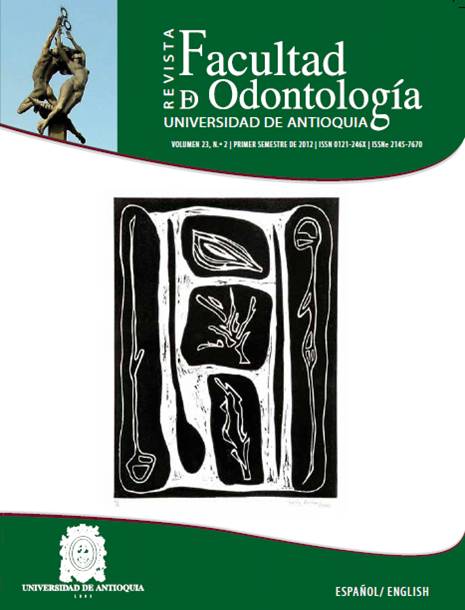Relationship between posterior dentoalveolar vertical dimension and skeletal classification in orthodontic patients treated with and without first premolar extractions: a cephalometric analysis
DOI:
https://doi.org/10.17533/udea.rfo.9642Keywords:
Orthodontics, Cephalometric analysis, Vertical dimension, Malocclusion, Premolar extractionsAbstract
Introduction: the purpose of this study was to determine and to cephalometrically compare the variation of posterior dentoalveolar vertical dimension in orthodontic patients treated with and without extraction of first premolars in Class I and Class II malocclusions and to establish its correlation by means of the Anteroposterior Dysplasia Indicator (APDI). Mehods: pre (T1) and post (T2) treatment lateral cephalograms of 76 patients from Fundación CIEO, aged 22 to 45 years, were skeletally classified according to APDI and the type of treatment received, regardless of gender, forming four groups: Class I with and without extractions, and Class II with and without extractions. The posterior dentoalveolar vertical dimension was calculated with linear measurements and its variation among the malocclusion groups was statistically analyzed; also, a multiple correlation analysis between dentoalveolar heights and APDI was performed at T1 and T2. Results: the intragroup analysis showed a significant increase of posterior dentoalveolar vertical dimension at T1 and T2 in both Class I and Class II groups with first premolar extractions at the lower second premolar (5i) and upper second molar (7s), respectively. The intergroup analysis showed a significant increase in posterior dentoalveolar vertical dimension, according to skeletal malocclusion class, in treatments with first premolar extractions, at the upper second premolar (5s), upper first molar (6s), upper second molar (7s), and lower first molar (6i). Conclusions: there was an increase of posterior dentoalveolar vertical dimension at T1 and T2 in all the groups, being statistically significant in Class I and Class II patients treated with first premolar extractions without altering the skeletal classification (APDI).
Downloads
Downloads
Published
How to Cite
Issue
Section
Categories
License
Copyright (c) 2012 Revista Facultad de Odontología Universidad de Antioquia

This work is licensed under a Creative Commons Attribution-NonCommercial-ShareAlike 4.0 International License.
Copyright Notice
Copyright comprises moral and patrimonial rights.
1. Moral rights: are born at the moment of the creation of the work, without the need to register it. They belong to the author in a personal and unrelinquishable manner; also, they are imprescriptible, unalienable and non negotiable. Moral rights are the right to paternity of the work, the right to integrity of the work, the right to maintain the work unedited or to publish it under a pseudonym or anonymously, the right to modify the work, the right to repent and, the right to be mentioned, in accordance with the definitions established in article 40 of Intellectual property bylaws of the Universidad (RECTORAL RESOLUTION 21231 of 2005).
2. Patrimonial rights: they consist of the capacity of financially dispose and benefit from the work trough any mean. Also, the patrimonial rights are relinquishable, attachable, prescriptive, temporary and transmissible, and they are caused with the publication or divulgation of the work. To the effect of publication of articles in the journal Revista de la Facultad de Odontología, it is understood that Universidad de Antioquia is the owner of the patrimonial rights of the contents of the publication.
The content of the publications is the exclusive responsibility of the authors. Neither the printing press, nor the editors, nor the Editorial Board will be responsible for the use of the information contained in the articles.
I, we, the author(s), and through me (us), the Entity for which I, am (are) working, hereby transfer in a total and definitive manner and without any limitation, to the Revista Facultad de Odontología Universidad de Antioquia, the patrimonial rights corresponding to the article presented for physical and digital publication. I also declare that neither this article, nor part of it has been published in another journal.
Open Access Policy
The articles published in our Journal are fully open access, as we consider that providing the public with free access to research contributes to a greater global exchange of knowledge.
Creative Commons License
The Journal offers its content to third parties without any kind of economic compensation or embargo on the articles. Articles are published under the terms of a Creative Commons license, known as Attribution – NonCommercial – Share Alike (BY-NC-SA), which permits use, distribution and reproduction in any medium, provided that the original work is properly cited and that the new productions are licensed under the same conditions.
![]()
This work is licensed under a Creative Commons Attribution-NonCommercial-ShareAlike 4.0 International License.













